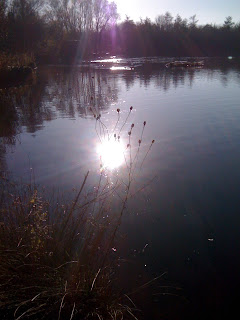'Deck the halls with boughs of Holly...' or so the popular carol goes.
Unfortunately, Christmas decorations are more likely to consist of an array of flashing lights, glitz and tack these days, rather than the symbolic, nature-inspired trimmings that would once have adorned our homes.
Most traditional decorations cost nothing because they were made from whatever was found growing in the gardens, hedgerows and woodland, but materials were also chosen for what they symbolised.
For example, evergreen cuttings have been used since the time of the Druids, who favoured them because they remained green throughout the bleak winter days. The prickly spikes of Holly were said to ward off evil spirits, while Mistletoe was thought to possess magical properties and regarded as sacred.
The use of these plants continued with the advent of Christianity, when the white berries of Mistletoe were chosen to represent purity. Holly leaves were said to symbolise the crown of thorns and the berries were the blood of Christ.
There are numerous theories about the origins of the Christmas Tree. It's thought that the idea of decorating a fir tree dates back to Roman times. During the Middle Ages, trees were decorated with apples to represent the tree of life from the Garden of Eden.
The modern custom of bringing a fire tree into the home at Christmas is thought to have originated in Germany and came here with Queen Victoria's husband, Prince Albert. The Victorians embraced this idea; known for their love of excess, they began decorating their trees with glass baubles, silver wire and tinsel. Although the range of decorations on the market today is endless, there is something timeless and satisfying about creating your own, homemade ornaments and displays based on traditional methods.
Here are a few ideas to get you started:
Advent rings, wreaths and garlands
An Advent ring makes a pretty table centrepiece and contains four candles - one for each of the four Sundays of Advent. The base is a ring of fresh oasis, which is available from all good florists. Dampen the oasis and cover it completely in fresh foliage; I use a combination of glossy evergreens, such as Holly, Ivy, Winter Jasmine, Rosemary, Laurel, Eucalyptus and whatever else I can find in the garden. Insert the four candles at evenly spaced intervals - you can secure them by taping cocktail sticks to the bottom and pushing these into the oasis. You can then add lengths of ribbon fashioned into bows; pieces of fruit; pine cones; baubles and any other finishing touches you like, attaching them to the oasis with lengths of wire (available from florists and craft shops).
You can create an attractive wreath for your front door using a similar method. Simply cover a fresh oasis ring in foliage, adding the decorations of your choice, and hang it from a length of ribbon, which can be attached to your front door to give guests a cheery welcome.
If you find the idea of making an Advent ring or wreath too daunting and want to opt for something more simple, evergreens also look striking gathered together in bundles and tied with ribbon or raffia, or twisted into informal wreaths and garlands. These can be hung from doors, picture frames, mirrors or a mantelpiece.
Dried materials
There's a fragile beauty to the dried out seed heads, weathered fronds of bracken and grasses, and skeletal twigs that are all that remain of summer's lush foliage. These dried materials make a delicate but wintry-looking alternative to fresh foliage, especially when a little gold or silver spray (available from craft shops) is used to highlight them. You can collect these items from the hedgerows during walks in the countryside, along with pine cones and jewel-coloured fallen leaves.
Gilded pine cones look attractive displayed in a basket or glass bowl. Fallen leaves can be dried out and then wired to long stems of twisted Willow or Hazel arranged in a tall vase to make an unusual alternative to a Christmas tree. The soft light of candles creates a cosy, festive feel and they work best when grouped together in the centre of a table or arranged on a hearth around a roaring fire.
Christmas tree decorations
Red ribbon looped into pretty bows, rosy red apples and pine cones embellished with a touch of gold spray make attractive and cost-effective Christmas tree decorations. Slices of orange can be slowly dried out in the oven at a low temperature and then attached to the branches using lengths of fine wire, along with small bundles of cinnamon sticks, which will smell amazing, as well as looking good.
Once you get started, you'll find that the possibilities are endless. Whatever you decide to make, take your inspiration from the natural world this Christmas. After all, most of the materials you need are free of charge and there for the taking.





No comments:
Post a Comment